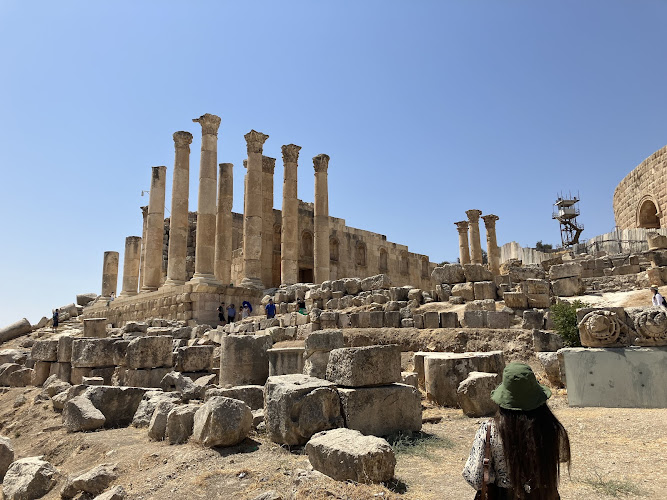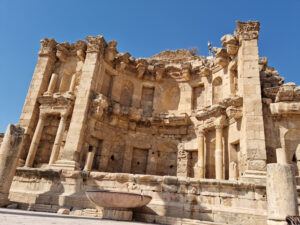
About Propylaeum of the Sanctuary of Zeus
Description
Let me tell you about one of the most fascinating ancient structures I've ever encountered. The Propylaeum of the Sanctuary of Zeus stands as a remarkable testament to classical Greek architecture, and I was absolutely blown away when I first saw it. This monumental gateway once served as the grand entrance to the sacred precinct dedicated to Zeus, and even today, its remaining elements speak volumes about the architectural brilliance of ancient Greece. Ya know what really gets me? The sheer scale of this thing! The massive columns and intricate stonework showcase the incredible precision of ancient Greek builders. Having visited numerous archaeological sites across Greece, I can tell you this one's pretty special. The way the sunlight plays off the ancient marble in the late afternoon - it's simply magical.Key Features
• Imposing Doric columns that still maintain their original proportions • Expertly crafted marble blocks showing ancient construction techniques • Original threshold stones with visible wear patterns from centuries of pilgrims • Architectural details revealing both form and function of religious processions • Remnants of ancient Greek inscriptions on select stone blocks • Strategic positioning that creates a dramatic approach to the sanctuary • Evidence of various historical periods and architectural modifications • Preserved ancient drainage system demonstrating engineering sophisticationBest Time to Visit
From my experience, early spring (March-April) or late autumn (October-November) offer the most pleasant conditions for exploring the Propylaeum. The weather's typically mild during these months, and you won't have to battle the intense summer heat that can make examining the ruins pretty uncomfortable. Plus, these shoulder seasons tend to bring fewer crowds, giving you space to really soak in the historical atmosphere. I'd especially recommend planning your visit for early morning or late afternoon - the lighting during these times really brings out the architectural details and makes for amazing photos. And trust me on this one - avoid visiting during midday in summer months when temperatures can be brutal and there's practically no shade.How to Get There
Getting to the Propylaeum isn't too tricky, but you'll want to plan ahead. If you're driving, there's decent parking available nearby, though it can fill up during peak season. From Athens, you can catch regular buses that'll get you pretty close - I've done this route myself and found it pretty straightforward. For those using public transportation, several local buses service the area. But here's a pro tip from someone who learned the hard way: double-check the return bus schedules, especially during off-season, as they can be less frequent than you might expect.Tips for Visiting
Look, I'm gonna share some real talk based on my multiple visits here. First off, wear sturdy shoes - the ground is uneven and those ancient stones can be slippery. I once made the mistake of wearing sandals and regretted it about 10 minutes in. Bring plenty of water and maybe a hat - there's limited shade around the site. I'd also suggest carrying a good camera because the architectural details are incredible and you'll want to capture them. If you're into photography like me, a polarizing filter can help reduce glare from the marble. Consider hiring a guide or at least bringing a good guidebook. The site's historical significance really comes alive when you understand what you're looking at. I remember standing there pretty clueless during my first visit until a friendly archaeologist explained the significance of various architectural elements. Oh, and don't forget to check out the less obvious details - like the ancient mason's marks on some blocks or the worn spots where thousands of ancient feet once trod. These little details really make the history feel real, ya know? Lastly, try to allocate at least 1-2 hours for your visit. Sure, you could rush through in 30 minutes, but why would you? Take your time, soak in the atmosphere, and imagine the countless people who've passed through this gateway over the centuries. It's quite something when you really think about it.Description
Let me tell you about one of the most fascinating ancient structures I’ve ever encountered. The Propylaeum of the Sanctuary of Zeus stands as a remarkable testament to classical Greek architecture, and I was absolutely blown away when I first saw it. This monumental gateway once served as the grand entrance to the sacred precinct dedicated to Zeus, and even today, its remaining elements speak volumes about the architectural brilliance of ancient Greece.
Ya know what really gets me? The sheer scale of this thing! The massive columns and intricate stonework showcase the incredible precision of ancient Greek builders. Having visited numerous archaeological sites across Greece, I can tell you this one’s pretty special. The way the sunlight plays off the ancient marble in the late afternoon – it’s simply magical.
Key Features
• Imposing Doric columns that still maintain their original proportions
• Expertly crafted marble blocks showing ancient construction techniques
• Original threshold stones with visible wear patterns from centuries of pilgrims
• Architectural details revealing both form and function of religious processions
• Remnants of ancient Greek inscriptions on select stone blocks
• Strategic positioning that creates a dramatic approach to the sanctuary
• Evidence of various historical periods and architectural modifications
• Preserved ancient drainage system demonstrating engineering sophistication
Best Time to Visit
From my experience, early spring (March-April) or late autumn (October-November) offer the most pleasant conditions for exploring the Propylaeum. The weather’s typically mild during these months, and you won’t have to battle the intense summer heat that can make examining the ruins pretty uncomfortable. Plus, these shoulder seasons tend to bring fewer crowds, giving you space to really soak in the historical atmosphere.
I’d especially recommend planning your visit for early morning or late afternoon – the lighting during these times really brings out the architectural details and makes for amazing photos. And trust me on this one – avoid visiting during midday in summer months when temperatures can be brutal and there’s practically no shade.
How to Get There
Getting to the Propylaeum isn’t too tricky, but you’ll want to plan ahead. If you’re driving, there’s decent parking available nearby, though it can fill up during peak season. From Athens, you can catch regular buses that’ll get you pretty close – I’ve done this route myself and found it pretty straightforward.
For those using public transportation, several local buses service the area. But here’s a pro tip from someone who learned the hard way: double-check the return bus schedules, especially during off-season, as they can be less frequent than you might expect.
Tips for Visiting
Look, I’m gonna share some real talk based on my multiple visits here. First off, wear sturdy shoes – the ground is uneven and those ancient stones can be slippery. I once made the mistake of wearing sandals and regretted it about 10 minutes in.
Bring plenty of water and maybe a hat – there’s limited shade around the site. I’d also suggest carrying a good camera because the architectural details are incredible and you’ll want to capture them. If you’re into photography like me, a polarizing filter can help reduce glare from the marble.
Consider hiring a guide or at least bringing a good guidebook. The site’s historical significance really comes alive when you understand what you’re looking at. I remember standing there pretty clueless during my first visit until a friendly archaeologist explained the significance of various architectural elements.
Oh, and don’t forget to check out the less obvious details – like the ancient mason’s marks on some blocks or the worn spots where thousands of ancient feet once trod. These little details really make the history feel real, ya know?
Lastly, try to allocate at least 1-2 hours for your visit. Sure, you could rush through in 30 minutes, but why would you? Take your time, soak in the atmosphere, and imagine the countless people who’ve passed through this gateway over the centuries. It’s quite something when you really think about it.
Location
Places to Stay Near Propylaeum of the Sanctuary of Zeus
Find Tours in Jerash
Explore More Travel Guides
No reviews found! Be the first to review!


